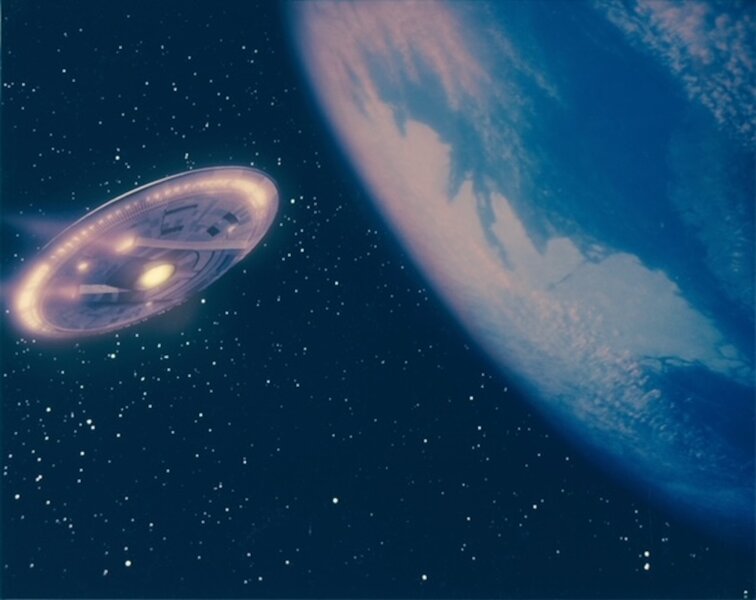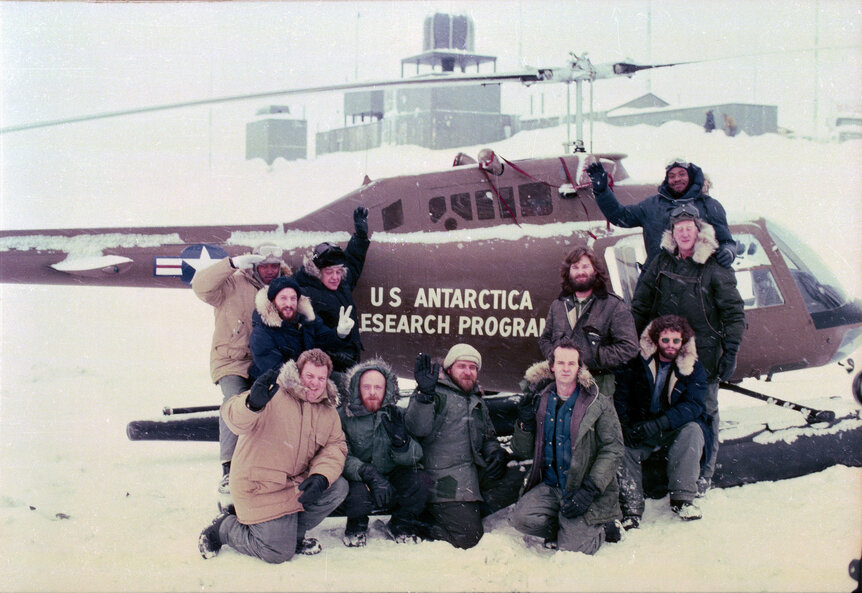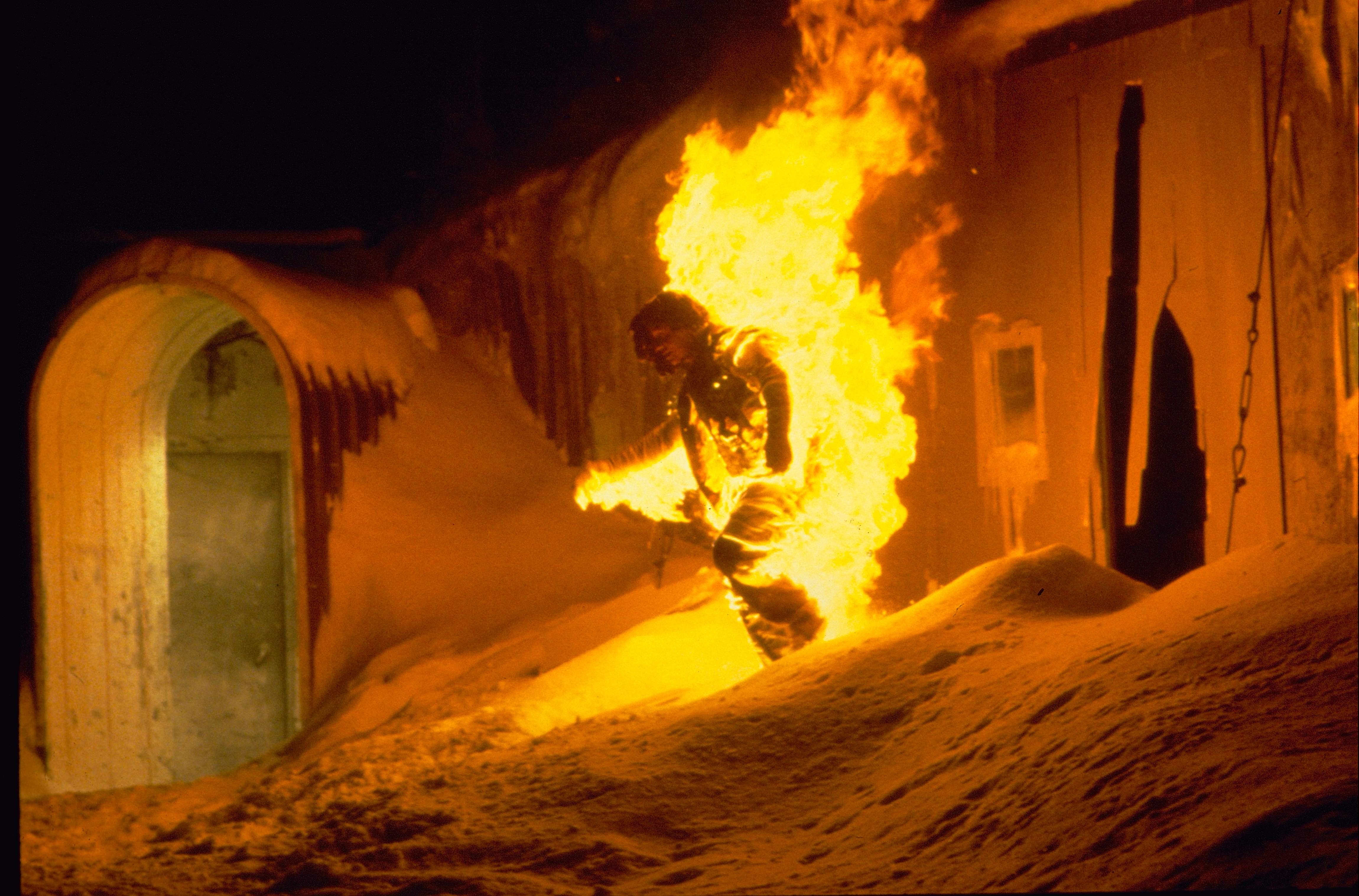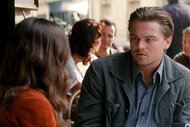Create a free profile to get unlimited access to exclusive videos, sweepstakes, and more!
Return of The Thing? Everything to Know About The Canceled Miniseries Sequel to The Thing
Return of the Thing would have tapped into the "ghosts of the Cold War."

What if the shape-shifting monstrosity of John Carpenter's 1982 remake of The Thing (now streaming on Peacock) had succeeded in its plan to escape the desolation of the Antarctic and infect the entirety of the world's population? We nearly got an answer to that chilling question from director Frank Darabont (acclaimed filmmaker of The Shawshank Redemption and The Green Mile) and screenwriter David Leslie Johnson-McGoldrick (The Walking Dead, Aquaman). The latter was serving as Darabont's assistant during the five-year period between Shawshank and Green Mile when he finally got around to checking out the Carpenter classic.
"I used to house sit for [Frank] a lot," Johnson-McGoldrick tells SYFY WIRE over Zoom. "And this being the ‘90s, he had this huge LaserDisc collection. I had never seen The Thing. It came out when I was 13 and I missed it. I was into E.T. when I was 13, not The Thing. And so, it was at his house that I watched The Thing for the first time and fell in love with it and realized what I had been missing."
While the screenwriting hopeful would ultimately strike out on his own for what would become a fruitful Hollywood career, he still retained a part-time role at the offices of Darabont's production company — Darkwoods Productions — in the late 1990s and early 2000s when the SYFY network (then styling itself as Sci Fi) sent out a call to scribes across Tinseltown. They wanted a miniseries script hot enough to thaw out The Thing IP.
"At the time, the Sci Fi Channel was obviously having a lot of success with their miniseries, and their sci-fi movies," he recalls. "They were sitting on this property and they wanted to do something with it. When it came to me, though, the pitch that I was hearing [is that] they wanted a reinvention. They were like, ‘Take the source material, turn into something else. It's no connection to the John Carpenter movie. It was remade once, we'll remake it again.’ Make the creature something different, make it so that it can turn to any kind of object.’ It was really blue sky at the time."
Johnson-McGoldrick landed the gig by realizing one simple fact: there was no improving on the 1982 film, which had been deservedly reappraised as a cinematic triumph in the years following its abysmal box office and critical performance. The groundbreaking creature effects of Rob Bottin gave pop culture "one of the most iconic creatures in horror," explains the screenwriter. "You have the [Xenomorph], you have the Predator, and you have the Thing all in rapid succession in the [late ‘70s and throughout the] ‘80s and they're all incredibly iconic. I pitched them that this was the equivalent of trying to reimagine the [Xenomorph] or trying to reimagine the Predator ... They saw the value in retaining that initial iconic imagery and iconic story."
In essence, he pitched the network "the opposite of what they wanted" by proposing a direct sequel to the Carpenter movie. The result was Return of the Thing, a four-hour miniseries that was equal parts John Carpenter, Michael Crichton, and Stephen King — with just a dash of Rod Serling. If pulled off correctly, the two-night television event had the potential to not only become just as beloved as the '82 film, but serve as a backdoor pilot for an entire series.
The script — which can be found online if you look hard enough — considerably expands the scope of The Thing mythos, with the addition of political backstabbing, a redemption story, Native American folklore, family drama, wild action set pieces, a pseudo-origin story for the creature itself, and, of course, plenty of sickening body horror that pays homage to Bottin while carrying the franchise into horrifyingly new territory. None of it should work and yet, it does — incredibly well. You might even say that Johnson-McGoldrick was attempting to do what James Cameron did for the Alien franchise.
Darabont's longtime friend and KNB EFX Group co-founder, Greg Nicotero, was tapped for the practical creature effects and provided "a lot" of early concept work before the miniseries stalled out (Darabont and Nicotero would later collaborate on The Mist and The Walking Dead). "I think there's kind of something magical that happens when you combine practical with CGI," says Johnson-McGoldrick. "You’re using the CGI to just remove the seams a bit. I think that would have been really exciting and Nicotero had a ton of great ideas for it.
The Setting of The Thing Miniseries That Was Never Made
Set in the mid-2000s, a little over two decades after the insanity at Outpost 31, Return of the Thing would have followed a multi-layered narrative in which the U.S. government attempts to contain the spread of the alien entity in a small and isolated New Mexico town. The paranoia and bodily transformations of the original are amped up to levels hitherto unseen in the ambitious miniseries script first submitted in early 2005. Johnson-McGoldrick immediately approached Darabont to direct (the filmmaker already had experience with revamping '50s-era properties, having written the screenplay for Chuck Russell's 1988 update of The Blob).
"We were very much on the same page in terms of just wanting to evoke the same tone of the original," remembers the screenwriter. "Basically, to tell a new story, but really be faithful to the Carpenter tone and to really move forward. If you look at the pilot for The Walking Dead, it's still one the best hours of TV [and] maybe one of the best pilots ever [Darabont developed Robert Kirkman's undead comic for the small screen]. It's so cinematic and that was really his approach. At a time before the new golden age of television, he wanted to make cinematic TV. And that was kind of a new idea when we were proposing this."
The Cold War underpinnings of the 1951 and 1982 adaptations were reinterpreted for a post-9/11 world, one haunted by what Johnson-McGoldrick calls the "ghosts" of America's 20th-century tensions with the Soviet Union. Return of the Thing begins with a prologue in which Russian bio-weapons experts (led by Dr. Yuri Lukanov and his wife, Alina) discover the charred ruins of Outpost 31, the frozen bodies of MacReady and Childs (yes, there is a resolution to that ambiguous ending), as well as the spaceship that crash-landed on Earth eons ago.
They bring the saucer and living tissue samples of the shape-shifter back to the USSR, hoping to weaponize the extra-terrestrial against the West. Once it becomes clear that the alien cannot be controlled, however, the project is scrapped. A single vial of the Thing's blood is kept on ice and lost to the annals of history once the Communist regime collapses in the early '90s. Years pass until a band of Chechen rebels break into the lab on Vozrozhdeniya Island and steal the dangerous sample, believing it to be a strain of weaponized smallpox. What begins as a plan to launch a terrorist attack against the United States turns into an all-out battle for the continuity of mankind.
"When we were [developing the miniseries], it was a big time of flux for Russia and there was a lot of alarm about what was happening to their nuclear materials, what was happening with crime and organized crime," the writer continues. "So, we landed on this idea of, ‘That's how the Thing slips through the cracks, is in the fall of the Soviet Union. There's this lab somewhere that was forgotten about.’ But the other thing that seemed really pertinent was the re-emergence of threats that were created during the Cold War or as a result of the Cold War. We funded a lot of what was going on in Afghanistan to overthrow the Russians and then it comes back and bites us in the ass on 9/11. So the idea was, ‘Could these ghosts of the Cold War be part of our theme?’"
As the only person truly aware of what the alien is truly capable of, Lukanov travels to America at great personal risk, determined to see the abominable creature eradicated once and for all — even if it means dropping an atomic bomb on U.S. citizens.
"We were sequel-izing The Thing, but we were also big John Carpenter fans. And so, we were really trying to figure out, ‘Who are the archetypes of the of the Carpenter pantheon that we can bring into it?’" reveals Johnson-McGoldrick. "We created a Russian scientist for the miniseries, who's obsessed with finding the Thing and is always going, 'You have to find it! You have to destroy it! It’s basically evil incarnate!’ He was our Dr. Loomis ... Our idea was to go through and pepper it with [Carpenter homages]. He wasn't going to be doing it, but we could try to imagine, ‘Who would Carpenter bring to the table?’ and really steer into his archetypes."
Lukanov is established to be an erudite and cautious authority on the Thing when the script throws us for an unexpected loop: the creature has become immune to MacReady's famous hot wire blood test in the same way bacteria evolves to evade the efficacy of antibiotics. "The tricky thing with a sequel is always [that] the audience wants everything that they saw before, but they don't want you to do the same old s***. They're gonna be really mad if you just do the same thing over again. It's really tricky trying to ride that line between, ‘I’m gonna give you what you want, but I'm also going to surprise you.’ And so, we went into it thinking, ‘Can we just do the heat test again?’ It felt like we'd seen that and we didn't want to address that again."
Instead of treading familiar ground, the miniseries concocts its own test. Based on all the evidence of the New Mexico outbreak, Lukanov discovers that powerful currents of electricity will force the alien to reveal itself and regress to past life forms it has imitated. In fact, enough shocks can force the darned Thing to show its original form. The greatest part of the whole thing was that Carpenter himself had set the precedent.
"It’s not necessarily intended in the movie, but another time that the Thing really reacts is with the defibrillator paddles," the writer says. "We kind of reverse-engineered from that, ‘Is there also an electricity component? Could the electricity disrupt it and force it to change shape? Maybe that’s why the Doc [played by Richard Dysart] got his arms bitten off, because he was using the defibrillator.’ So we used the defibrillators early on in the script and then hopefully, came up with something that would be our new test, but wouldn't feel like a cheat because we could say, 'Well, maybe that was what was being hinted at in the original.’"
The idea of taking what fans have seen before and presenting it in a much bigger and surprising way would have pervaded every aspect of the miniseries, especially its climax, which turns the visual of Norris's head sprouting legs and attempting to crawl away unnoticed..well, on its head.
"One of the big things that Frank wanted to do that I thought was great, was at the end of the show, we had a swarm of spider heads," Johnson-McGoldrick tells us. "I think the spider head is everybody's most iconic memory of that movie. Between that and the defibrillator, those are the two [visuals] that really pop in people's heads. On the one hand, we didn't want to copy the head spider, we didn't want to make that less special. But at the same time, we still really, really, really wanted to see it. I think taking the head spider and turning it into an army of head spiders was just too fun to say 'No' to. So we took that for a spin and I think that was one of the things that people would have dug — that nod to the original, but taking it to another level."
Why Return of The Thing Was Never Made
Return of the Thing ended up in a state of suspended animation, partly due to budget concerns. Around the same time, Universal Pictures decided to shift its focus to a big screen revival that took the form of a 2011 prequel set at the Norwegian camp. "This was about the same time everybody was rediscovering their horror IPs in the feature space. You had the Hitcher remake, you had the Friday, the 13th remake, you had A Nightmare on Elm Street remake. All the theatrical sides of these corporations were going into their IP libraries and saying, 'What can we put back into theaters?’" says Johnson-McGoldrick, who feels like there was plenty of room in Antarctica for both projects.
"I always felt like they could have coexisted. The prequel goes back in time and we go forward and they don't conflict with each other in any way. I remember when I finally saw the prequel, at the very end, they mentioned that there's a Russian base nearby, and I was like, ‘It's perfect! We dovetail exactly with where we want to be. They just set up the Russian base that’s going to come and find this stuff in our movie.’ But it just wasn't to be."
He and NBCUniversal reportedly revisited the miniseries during the pandemic with the hopes of turning it into a full-blown television show that retained the bleak nihilism of the Carpenter film. A slightly updated version of the four-hour script was to be stretched across the first season.
"The series that we had in mind was ... Blair's countdown [from the movie]. If this Thing ever got to the general population, this is how long it would take for the entire world to be assimilated. Our idea was, ‘What if the entire series is that countdown? The Thing wins in the end. You get to season five or whatever and it’s done, but the whole time, we’re set on Blair’s timeline and we’re just counting down until the end."
Coming back to the project with fresh eyes convinced the writer to rethink the idea of providing a firm answer of who was and wasn't human at the end of the Carpenter film. Had this new version moved forward, fans might have seen the return of MacReady, Childs, or perhaps both. During its initial gestation period at the turn of the millennium, however, "the idea of Kurt Russell doing a TV show was preposterous," the writer explains. "Now, we have movie stars doing TV shows all the time. So definitely one of the [important] things when we were trying to think about this to update it or revisit it, was, ‘Do we even want to answer that question? Or do we want to dangle that out there as a possibility that maybe he [Russell] could return? Maybe we don't want to answer that question just yet.’ I don't know, it’s such a great mystery. On the one hand, it was really fun to answer. But on the other hand, it was like, ‘But did we ever want to know?’ I don't know. I'm still confused about that one."
Unfortunately, this second attempt also led nowhere, but Johnson-McGoldrick bears no ill will. "It’s an opportunity a lot of fans would like to have, regardless of whether it got made or not," he concludes. "I got paid to write Thing fanfic, so I don't see what the downside is frankly."
The Thing is now streaming on Peacock!
Originally published Sep 12, 2022.





























